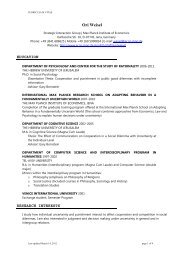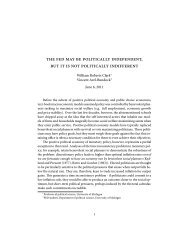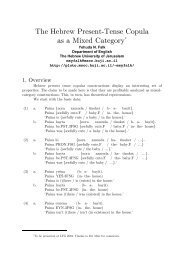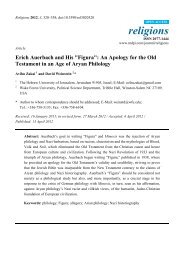Transitive verbs with non-accusative alternation in ... - Pluto Huji Ac Il
Transitive verbs with non-accusative alternation in ... - Pluto Huji Ac Il
Transitive verbs with non-accusative alternation in ... - Pluto Huji Ac Il
You also want an ePaper? Increase the reach of your titles
YUMPU automatically turns print PDFs into web optimized ePapers that Google loves.
98<br />
Rivka Halevy<br />
7. The ‘aspectual’ <strong>verbs</strong> to be discussed function as <strong>in</strong>dicators of the Aktionsart of<br />
the ‘ma<strong>in</strong>’ verb . Although they usually modify a predicative nom<strong>in</strong>al<br />
complement <strong>in</strong> an <strong>in</strong>f<strong>in</strong>itival or gerundive form, they are not true auxiliaries.<br />
8. Contextual clues often contribute to enhance the mean<strong>in</strong>g imposed by the<br />
prepositional construction frame, e.g., bexavana (‘deliberately’) <strong>in</strong> (25) below.<br />
9. Cf. Havers (1931: 168): “ Die nom<strong>in</strong>a <strong>in</strong>gressiven S<strong>in</strong>nes können zu Durativa<br />
‘gestreckt’ werden. Der Vorgand besteht nach Brugmann dar<strong>in</strong>, ‘daβ der<br />
eigentliche Worts<strong>in</strong>n nur auf e<strong>in</strong>en Beg<strong>in</strong>n, e<strong>in</strong> erstes Stadium geht, während <strong>in</strong><br />
mehr oder m<strong>in</strong>der bestimmter Weise das mit vorgestellt und geme<strong>in</strong>t ist, was<br />
auf den Anfang folgt’(S. 28)”. For more bibliographical references on this<br />
phenome<strong>non</strong> <strong>in</strong> Indo-European languages, see Havers (1931: 259 n. 148).<br />
10. This is similar to Spanish, as demonstrated, amongst others, by Delbecque<br />
(1999a, 1999b, 2002).<br />
11. See also Roegiest (this volume).<br />
12. On lexical impregnation, see Halevy (1996: 26).<br />
13. In Modern Hebrew, the coreferential dative does not necessarily yield a<br />
reflexive <strong>in</strong>terpretation. Here it reflects the typical expanded use of the<br />
expressive dative (viz., which is not part of the verb valency) added <strong>in</strong><br />
colloquial speech to <strong>verbs</strong> of movement viewed imperfectively as be<strong>in</strong>g<br />
performed <strong>in</strong> a casual manner (cf. Halevy <strong>in</strong> pr<strong>in</strong>t).<br />
14. For a discussion of the ‘holistic effect’ vs. ‘partitive effect’ associated <strong>with</strong><br />
certa<strong>in</strong> verb classes, see Lev<strong>in</strong> (1993).<br />
15. Cf. Arrivé, Gadet and Galmiche (1986: 391): “les modes personnelles<br />
permettent de marquer les différents degrés d’actualisation du procès signifié<br />
par le verbe”.<br />
16. Cf. Delbecque (1999a: 417) regard<strong>in</strong>g Ø/a transitivity <strong>alternation</strong> <strong>in</strong> Spanish.<br />
17. Cf. Delbecque (2002) for a similar <strong>alternation</strong> <strong>in</strong> Spanish <strong>with</strong> matar ‘kill’, and<br />
cf. section 7.2 below.<br />
17. Cf. Talmy 1985; Bybee 1985; Lev<strong>in</strong> 1993, amongst others.<br />
18. Cf. Lev<strong>in</strong> 1993:9 and 42) for the relevance of the notions of both ‘contact’ and<br />
‘motion’ to conative <strong>alternation</strong> <strong>in</strong> English.<br />
19. For syntactic properties of <strong>verbs</strong> of contact by motion <strong>in</strong> English see Lev<strong>in</strong><br />
(1993: 6–7).<br />
20. Passive mean<strong>in</strong>g is realized <strong>in</strong> Hebrew <strong>in</strong> the morphological system of the verb,<br />
e.g. <strong>in</strong> the verb-form of NIF’AL. Yet, passive forms, such as NIF’AL, may as<br />
well be employed to express other mean<strong>in</strong>gs besides passive, such as<br />
<strong>in</strong>choative and middle-passive as demonstrated <strong>in</strong> (56)–(57) (cf. 5.2.3).<br />
21. Cf. Rice (1987), amongst others.<br />
22. For ample documentation of transitivity <strong>in</strong> German vs. English, see for example<br />
Hawk<strong>in</strong>s (1986: Ch. 4).<br />
23. For a discussion of the expansion of the dative le- mark<strong>in</strong>g the affectee role <strong>in</strong><br />
Modern Hebrew see Berman (1982).<br />
24. For an extensive study of the dative and its roles <strong>in</strong> Spanish vs. English and<br />
some other European languages, see Delbecque and Lamiroy (1996), and<br />
Lamiroy and Delbecque (1998).



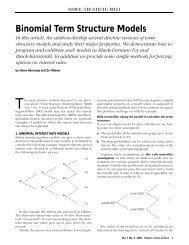
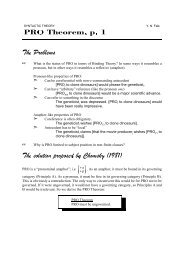
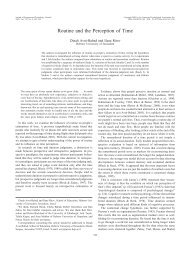
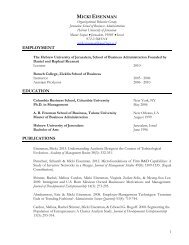
![CV [PDF] - Pluto Huji Ac Il](https://img.yumpu.com/18174585/1/190x245/cv-pdf-pluto-huji-ac-il.jpg?quality=85)

